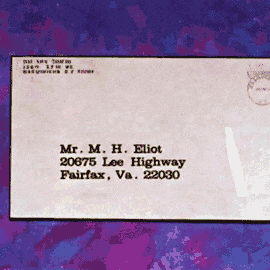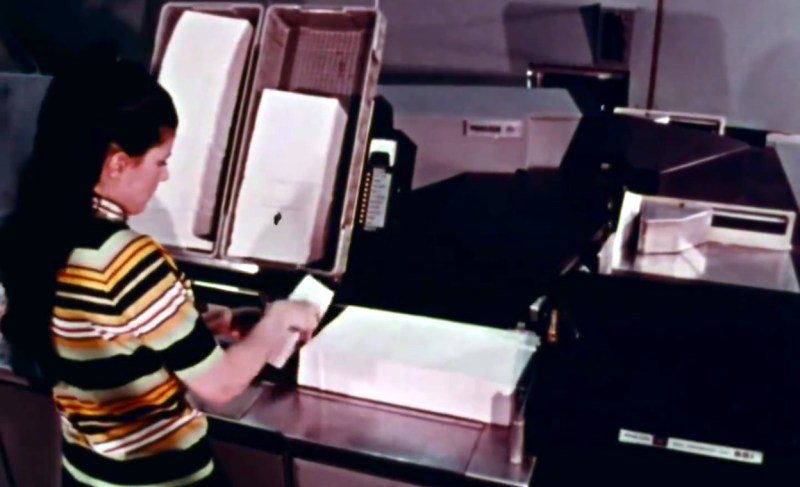We often read about the minicomputers of the 1960s, and see examples of their use in university research laboratories or medium-sized companies where they might have managed the accounts. It’s tempting though to believe that much of the world in those last decades of the analogue era remained untouched by computing, only succumbing in the decade of the microcomputer, or of the widespread use of the Internet.
What could be more synonymous with the pre-computing age than the mail system? Hundreds of years of processing hand-written letters, sorted by hand, transported by horses, boats, railroads and then motor transport, then delivered to your mailbox by your friendly local postman. How did minicomputer technology find its way into that environment?
Thus we come to today’s film, a 1970 US Postal Service short entitled “Reading And Sorting Mail Automatically”. In it we see the latest high-speed OCR systems processing thousands of letters an hour and sorting them by destination, and are treated to a description of the scanning technology.
If a Hackaday reader in 2017 was tasked with scanning and OCR-ing addresses, they would have high-resolution cameras and formidable computing power at their disposal. It wouldn’t be a trivial task to get it right, but it would be one that given suitable open-source OCR software could be achieved by most of us. By contrast the Philco engineers who manufactured the Postal Service’s scanners would have had to create them from scratch.
 This they performed in a curiously analogue manner, with a raster scan generated by a CRT. First a coarse scan to identify the address and its individual lines, then a fine scan to pick out the line they needed. An optical sensor could then pick up the reflected light and feed the information back to the computer for processing.
This they performed in a curiously analogue manner, with a raster scan generated by a CRT. First a coarse scan to identify the address and its individual lines, then a fine scan to pick out the line they needed. An optical sensor could then pick up the reflected light and feed the information back to the computer for processing.
The description of the OCR process is a seemingly straightforward one of recognizing the individual components of letters which probably required some impressive coding to achieve in the limited resources of a 1960s minicomputer. The system couldn’t process handwriting, instead it was reserved for OCR-compatible business mail.
Finally, the address lines are compared with a database of known US cities and states, and each letter is routed to the appropriate hopper. We are shown a magnetic drum data store, the precursor of our modern hard drives, and told that it holds an impressive 10 megabytes of data. For 1970, that was evidently a lot.
It’s quaint to see what seems to be such basic computing technology presented as the last word in sophistication, but the truth is that to achieve this level of functionality and performance with the technology of that era was an extremely impressive achievement. Sit back and enjoy the film, we’ve placed it below the break.
















In the hierarchy of “storage” technologies, Disk Drives were around back then and bigger than the Drum storage. The reason Drum was used was it’s high speed of read/write operations versus a spinning disk. Drum storage was not as fast as Magnetic cores, but was much faster than spinning disks, as there were multiple read/write heads all around the circumference of the drum. So programmers would allocate resources according to how fast the access as to each. Cpu registers were the top, followed by magnetic core, magnetic drum, hard disk drives, then magnetic tape. Each one being some magnitude slower than the previous device. The speed of Drum storage was so attractive, that some military applications of it existed long after it had become too expensive/cantankerous for commercial use. I know drum memory was used for the Missile systems on nuclear subs for long time after Drum memory dropped off the market for commercial computers.
Wasn’t there an early attempt at computer memory that used charged capacitors on a rotating drum?
The ABC computer did that. It might have been developed into the first commercial electronic computer except the grad student at Iowa State that did a lot of the work went off to WWII
Looks like it: https://books.google.com/books?id=piikBwAAQBAJ&pg=PA128&lpg=PA128&dq=charged+capacitor+on+rotating+drum&source=bl&ots=EWzTpdvx9w&sig=CmepXA7CL1V2IG8-mQDaqQ9xBSU&hl=en&sa=X&ved=0ahUKEwjEuv75grHUAhWGaT4KHTfdDz0Q6AEIKDAA#v=onepage&q=charged%20capacitor%20on%20rotating%20drum&f=false
And also the original Univac computers used a technology developed for radar units in WW2 called: Mercury Delay Lines. It was a piezo crystal at one end of a tube of mercury pulsing signals to a paired piezo crystal at the opposite end. The wave fronts denoted 1’s and O’s. The frequency chosen would allow as many as 500bits to be carried through the mercury, but temperature was always an issue. They had the heat the tubes in an oven to make sure there were fewer read/write errors as the signals went through.
BTW, projecting a CRT raster and picking up the reflection on a photodetector is called a flying spot scanner and saw a lot of use at one time. One of the proposals for color TV even used a three color flying spot scanner!
CRT-based cameras were similar, though it all happens inside of the tube.
Note the wood framed mirror over the hole where the mail goes through the wall that looks a bit out of place. I bet that was someone’s hack to solve a problem with mail falling off the line undetected.
> We are shown a magnetic drum data store, the precursor of our modern hard drives, and told that it holds an impressive 10 megabytes of data.
This is incorrect, in the video it’s mentioned to be 10 million bits which is only 125KB, not 10MB which would be over 8 times that.
Do your sums again. 10Mbit is 1.25MByte, not 125KByte. It’s still tiny by today’s standards, but not that tiny.
Let’s face it though, no-one could ever possibly use more than 640k anyway
In addition to that the machine probably didn’t even use bytes as its word size… so probably around 600 kilo words.
The greater point is, look at what humans can do with limited resources. Kind of like…hackers and makers. ;-)
Having lived through the 60s (yes, I’m old) you simply cannot believe how nice it is to have cellphones, powerful desk and laptops, tablets (right out of Star Trek) and the rest. Not to mention fiber to the curb. No more 300 baud dialup :-)
That can’t be true as I’m constantly being told how much better things were in the old days. (c:
Desktop computers instead of desk computers. But some people just gotta have a computer built into a desk these days.
Still waiting for someone to build a functional replica of Dillinger’s desk from the original TRON movie.
I think you could buy those shortly after the movie came out. The glare from the glass desktop covering the screen was a killer.
There’s been a couple DIY projects like this. You can get the Touch film and mount it to the back of a glass desktop then hang a display ( or maybe a high angle projector?) under that. It would look cool and have a high intimidation factor but actually working on it for more than 10 minutes or so would probably suck.
http://forum.arcadecontrols.com/index.php/topic,147366.40.html?PHPSESSID=ggol90povthc0vkbm0tgdeaik2
I was tempted to put a printer on the back of the letter box have it feed envelopes between a pair of scanner sensors, [to read both sides in one pass], then do some OCR to chuck them into a corresponding box and add the letter inventory to an excel sheet on my network. Never did get around to it (:
How many 555 times did it take to implement this system?
555 timers
I worked on a limited OCR project, and for testing it turns out that that is a sample database available from the USPS. It’s noted for being tough, and scores for even the best OCR readers are still a few percent away from perfect.